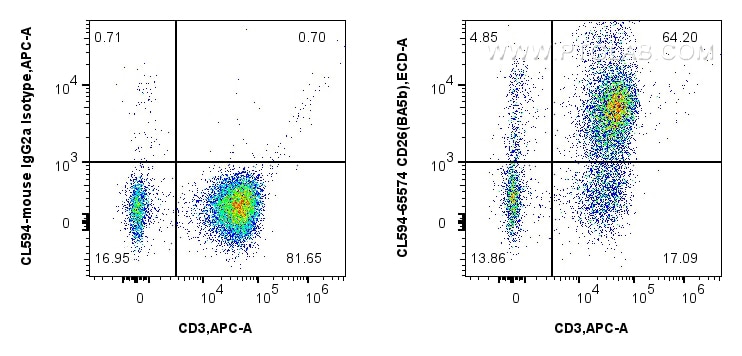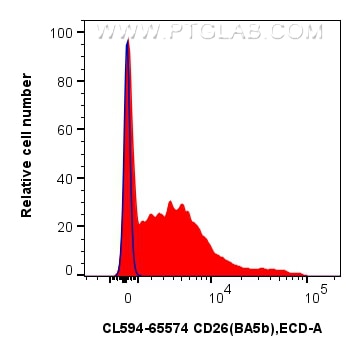Tested Applications
| Positive FC detected in | human PBMCs |
Recommended dilution
| Application | Dilution |
|---|---|
| Flow Cytometry (FC) | FC : 5 ul per 10^6 cells in 100 μl suspension |
| This reagent has been pre-titrated and tested for flow cytometric analysis. The suggested use of this reagent is 5 ul per 10^6 cells in a 100 µl suspension or 5 ul per 100 µl of whole blood. | |
| Sample-dependent, Check data in validation data gallery. | |
Product Information
CL594-65574 targets DPP4/CD26 in FC applications and shows reactivity with human samples.
| Tested Reactivity | human |
| Host / Isotype | Mouse / IgG2a |
| Class | Recombinant |
| Type | Antibody |
| Immunogen |
A human T cell clone Predict reactive species |
| Full Name | dipeptidyl-peptidase 4 |
| Calculated Molecular Weight | 88 kDa |
| GenBank Accession Number | BC013329 |
| Gene Symbol | DPP4 |
| Gene ID (NCBI) | 1803 |
| RRID | AB_3673486 |
| Conjugate | CoraLite®594 Fluorescent Dye |
| Excitation/Emission Maxima Wavelengths | 588 nm / 604 nm |
| Form | Liquid |
| Purification Method | Protein A purification |
| UNIPROT ID | P27487 |
| Storage Buffer | PBS with 0.09% sodium azide and 0.5% BSA, pH 7.3. |
| Storage Conditions | Store at 2-8°C. Avoid exposure to light. Stable for one year after shipment. |
Background Information
CD26, also known as DPP4 (dipeptidyl peptidase-4), is a 110 kDa type II cell-surface glycoprotein widely expressed on T cells, activated B cells, activated NK cells and myeloid cells as well as on epithelial cells, fibroblasts, mesothelium, and endothelial cells of a variety of tissues (PMID:33777580; 26919392). It has ecto-enzyme activity in its extracellular domain and cleaves amino-terminal dipeptides with either L-proline or L-alanine at the penultimate position (PMID: 9553764). CD26 plays roles in diverse biological processes such as immunoregulation, glucose homeostasis, and tumorigenesis (PMID: 33777580).
Protocols
| Product Specific Protocols | |
|---|---|
| FC protocol for CL594 DPP4/CD26 antibody CL594-65574 | Download protocol |
| Standard Protocols | |
|---|---|
| Click here to view our Standard Protocols |






